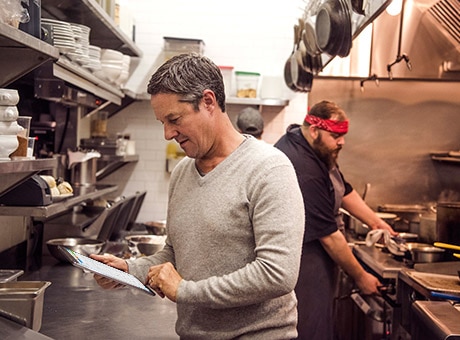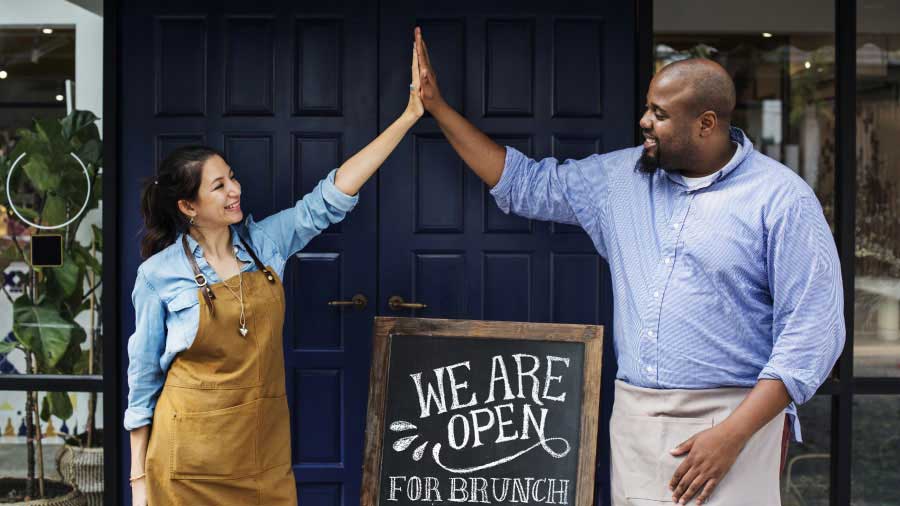When it comes to running a restaurant, there are a lot of factors to consider to keep the business humming smoothly. You have to make sure you’re stocked up on ingredients, ensure the grills are fired up every day, and schedule enough employees to cover the midday rush, get customer orders prepared properly, and pay your cooks and servers for their time on the clock. The restaurant ownership juggling act gets infinitely easier with restaurant accounting software from QuickBooks. Here are seven ways to leverage accounting software to run your restaurant successfully.

7 Ways to Use Restaurant Accounting Software
Inventory Tracking
As a restaurant owner, a large portion of the money you spend is on food and beverages, so it’s imperative that you manage this inventory well. Because much of your inventory is perishable, you have to strike a delicate balance when placing food orders to make sure you don’t have too much or too little at any given time.
While a surplus of paper napkins doesn’t pose as much of a problem, an overabundance of eggs or chicken breasts with a limited shelf life hurts your bottom line if the product goes to waste. To avoid the constant need to toss out spoiled and outdated food, restaurant owners often employ a single-period inventory system.
Rather than performing inventory annually like many businesses, this method necessitates much more frequent product counts. Go through walk-in freezers and other food-storage areas to get a current and accurate picture of your inventory before placing new orders. This ensures you don’t order four new cases of ham steaks when you already have several unused packages that are about to expire.
Many restaurants and other businesses with perishable inventory choose to employ the first-in, first-out method of inventory management. This advantageous method focuses on selling older inventory before using the most recently received goods. While this method helps you cut back on the need to throw out unused, expired and spoiled foods, it also benefits your small business’s profit margin when it comes to calculating the cost of goods sold (COGS). The equation for calculating the cost of goods sold is:
Beginning Inventory + Purchased Inventory – Final Inventory = Cost of Goods Sold
Imagine you start the month with $4,000 of perishable food inventory and purchase an additional $3,000 during the month. You end the month with $2,000 in inventory. This means your COGS for the month is $5,000. This is considered an expense and reduces your gross revenue. Since some waste is inevitable, keeping detailed records of the value of those unused items helps when tax time rolls around. The cost of these perishable goods inflates your COGS, reducing the income that’s taxed at year-end.
Diligent recordkeeping is imperative for restaurant owners, especially related to inventory tracking of perishable management, and restaurant accounting software makes the process easier. By reviewing reports of past sales, inventory, and revenue, you can identify trends and make reasonable assumptions when placing food orders. For example, you may notice that sales of blueberry pie triple during the summer months. This leads you to cut back on winter ordering of the dessert and schedule an extra delivery beginning in June.
Monitor Food and Beverage Sales
Running daily sales reports at the end of each business day provides you with a great deal of useful information. These figures serve as a snapshot of how your restaurant did on any particular day. With the right restaurant computer software, you can match daily sales with reports from your point of sale (POS) system to minimize errors. You also have the ability to determine the amount of food and beverage sales completed in a single day, a figure that could help you identify issues that need to be addressed with food quality or service.
Daily reconciliation is an important step for small-business owners. Reconcile daily revenues against settlement to determine whether your business is cash over or cash short.
Revenue typically includes:
- Food sales
- Beverage sales
- Merchandise sales
- Gift certificate sales
- Customer deposits on catering or banquet services
- Sales tax collected
- Credit card tips withheld
Here are some common items considered settlement:
- Cash deposits
- Credit card deposits
- Discounts
- Comped meals
- Coupons redeemed
- Gift certificates redeemed
- Accounts receivable
After arriving at a revenue total and a settlement total, deduct revenue from settlement. A negative balance indicates a cash shortage, while a positive value denotes a cash overage. Ideally, the reconciliation should be close to zero at the time of reconciliation every day.
When collected over time, daily sales reports become historical data that help you make decisions and determine whether small-business changes are needed. If food and beverage sales prove to be consistently low on Sunday afternoons, you might consider changing your weekend business hours or reducing the staffers you employ during that time.
Imagine sales of alcoholic beverages are 30% lower on Wednesday evenings compared to any other night of the week. This information may lead you to boost sales by implementing a cocktail hour or introducing draft specials on Wednesday nights. All of this management decision-making stems from accurate daily sales reporting, and small-restaurant accounting software helps you keep diligent records and sales figures to refer to at any given time.
Interface with Point of Sale Apps
Using small-restaurant point of sale systems in conjunction with your accounting software ties many aspects of your operation together. POS apps help to streamline front-of-the-house operations with a bevy of intuitive features. Servers can enter orders from a tablet, sending each table’s menu selections to the cook’s line with the press of a button.
Table layout programs allow your hostess to watch over the entire restaurant floor from one screen, overseeing table wait times, keeping track of reservations, and managing customer wait lists. Cashiers have the ability to split customer cheques, employ repeat-customer loyalty programs, and accept cash or credit card payments for the diner’s bill.
The advantages even extend to the back of the house with digital ticket displays and low stock alerts on food items. Delivery integration apps and online ordering systems help to expand your business so you can reach an even larger audience, while bar systems let you hold customer tabs and monitor liquor sales.
If used efficiently, POS systems work hand in hand with your accounting software to keep restaurant operations flowing without a hitch. Catering orders recorded in the system can interface with free restaurant billing software to generate an invoice to the client.
Reports generated at the end of every shift make you aware of the amount of credit card tips due to each server. When multiple servers input orders for poutine, your restaurant’s inventory management system can alert you instantly that you’re dangerously low on potatoes, letting you submit an overnight supply order to avoid out-of-stock menu items.
Comparing daily drink sales reported by your POS system with liquor inventory software lets you monitor your bar area with ease, making it easy to recognize when bartenders are over-pouring or giving away drinks for free.
Oversee Operating Expenses and Accounts Payable
Keeping your restaurant’s doors open requires more than just serving up delicious dishes, hiring a friendly wait staff and collecting customer payments. There are a lot of expenses that come along with running a small business.
First, there are occupancy expenses, which include items such as the cost of rent, insurance on the building, property taxes and janitorial services, as well as repairs and maintenance to the building and utility payments. Labour expenses are comprised of wage payments to your employees as well as any benefit payments, such as health insurance or employee discounts.
Other operating expenses to consider include licenses and permits, repair and maintenance of equipment, marketing costs, uniform expenses, menu printing and office supplies. You may also need to account for internet and telephone payments, bank and credit card fees, music and entertainment costs, and interest and depreciation expenses.
Your restaurant’s chart of accounts categorizes all of the money you take in and pay out by separating transactions into revenues, expenses, assets, liabilities, COGS, and equity. With the help of restaurant-accounting books, you can create a chart of accounts that’s specific to your business and build it into your restaurant-accounting software.
As you enter transactions, such as operating expenses, into the system, they populate into your chart of accounts accordingly, allowing you to create financial reports later, including cash flow reports, balance sheets, and profit and loss statements.
Accounts payable refers to the process of paying your suppliers and suppliers. Using small-restaurant software from QuickBooks, you can make sure invoices are paid accurately and on time, so there’s never a lapse in service or shipments. Before entering invoices into your accounting software and paying them, always establish a three-way match.
Check your restaurant’s purchase order, your restaurant’s receiving report, and the supplier’s invoice for accuracy. Make sure your restaurant received the entire order, verify that quantities and product descriptions match, and ensure that the total due to the supplier is accurate. If everything checks out, enter the invoice for payment to the supplier.
Your accounting software posts the expense appropriately to your chart of accounts and generates a cheque or electronic payment to the supplier for timely payment. Pay attention to the supplier’s payment terms. Some may require payment within 10 days, while others might allow 30 days or more. Establish a schedule for the accounts payable process, whether weekly or biweekly, to keep bills from piling up in the office and to ensure a positive business relationship with suppliers.
Process Payroll Transactions
Your employees are the heart of your restaurant, so it’s imperative that you keep them happy and paid. When it comes to payroll, there’s more to consider than just wages & time tracking. You should also think about deductions, benefits, overtime, payroll taxes, and more. To get started, you must register for an account with the Canada Revenue Agency (CRA) so you can turn in your deductions.
Applicable deductions include income tax, your share of your employees’ contribution to the Canada Pension Plan, and employment insurance. To accurately calculate each employee’s income tax responsibility and deductions, requires all workers to provide their Social Insurance Numbers (SIN) and fill out a Personal Tax Credits Return Form, or TD1.
With QuickBooks Online payroll features, it’s even easier to process payroll, whether your business pays its employees weekly, biweekly or even monthly. The accounting software lets you build each employee into the system along with their SIN and deductions, ensuring each worker receives payment at the appropriate hourly rate, overtime rate, or salary, and that deductions and taxes are assessed accurately.
The payroll system can also track each employee’s vacation hours and sick time, paying out for use of leave time if necessary. Further, accounting software aids in the calculation and deduction of taxes and deductions from your employees’ paycheques and helps to generate a total of the amount of payroll tax your small business owes to the CRA.
Finally, you can generate cheques for each of your employees for pickup or mailing, or offer the option of direct deposit as a convenience to your workers. At any time in the payroll process, you can run reports to meet your accounting needs, such as total payroll costs for front-of-the-house employees, cooks, or management.
Produce Employee Schedules
Few things in the restaurant industry are as stressful as entering into the dinner rush understaffed, making scheduling a highly important small-restaurant management task. Scheduling apps, take the guesswork out of scheduling employees, and they sync up with your QuickBooks Online accounting software for seamless reporting.
Scheduling often feels like an elaborate dance: You need enough employees to keep operations running smoothly but not too many, as this drives up payroll costs. You also have to consider time-off requests and prepare for call-offs. Using sales reports generated by your small-business accounting software, you know that the Sunday morning breakfast buffet draws a large crowd.
You can use this information for scheduling purposes, ensuring you have enough hostesses, servers, cashiers, cooks, dishwashers, and bussers to adequately cover the shift. When these scheduling apps interface with your accounting software, they feed reported hours to your payroll system to allow for easy processing of paycheques without the need to enter employee time cards manually.
Using a scheduling app in conjunction with your accounting software also improves communication with your employees. After creating the weekly work schedule, you can share it online for employees to check remotely. Many of these apps let employees submit time-off requests for your approval, and some allow workers to trade shifts with one another.
You can send alerts or notifications to all employees or just a select group of workers. If an employee calls off for the next shift, you can post the available hours for bidding to find a quick and willing replacement. Workers can clock in or out of their shifts easily — even remotely — which comes in handy if some employees work in alternate locations, such as a catering venue or food truck. If certain employees are nearing overtime, you receive an alert so you can keep payroll costs from running too high.
Generate Custom Reports
When you enter information completely and accurately into your accounting software, you can generate an endless array of useful reports to aid in informed decision making and the successful management of your small business. Analysis of just one report may lead you to make menu, staffing or management changes that can increase your bottom line and improve operations.
With QuickBooks, it’s simple to share financial statements and other reports with stakeholders. Whether they’re generated daily, weekly, monthly or annually, you can schedule specific reports and email them to your accountant, partners or colleagues. Get to know some of the financial reports you can generate with your restaurant accounting software, and discover how to use them to your advantage.
An income statement, also referred to as a statement of operations, statement of earnings, or profit and loss statement, serves as a checkup for your restaurant’s profitability. This statement, often prepared quarterly or annually, summarizes your business revenues, costs and expenses for that period.
Deduct expenses and costs from revenues to arrive at net income. You can use this report to determine where you can cut costs or decide on ways to increase the restaurant’s revenue. Compare the income statement with your budgeted spending plan to determine where they differ.
The balance sheet categorizes and lists assets, liabilities and owner’s equity. It’s sometimes referred to as a statement of financial position or a statement of assets and liabilities. This important financial statement provides a snapshot of your financial position, and you can generate this report at any time for an up-to-date overview of your business.
Assets include such items as:
- Cash
- Accounts receivable
- Inventory
- Fixed assets
Liabilities can include:
- Long-term debt
- Wages payable
- Bank loans
- Rent
Owner’s equity is the money attributed to the owner. On the balance sheet, the following formula always holds true:
liabilities + owner’s equity = assets
Use this report to analyze your small business’ liquidity and determine your restaurant’s net worth. As its name suggests, the cash flow statement, or statement of cash flows, tracks the flow of cash in and out of your restaurant. By generating this report, you can find out how much money you have on hand at any given moment. Broken down into three categories, the cash flow statement reports, cash flows from operations, investing, and financing.
Cash flows from operations may include accounts payable, depreciation and prepaid items, while cash flows from investing comprise of cash spent on property, plant or equipment. Cash flows from financing include debts, equity, and dividends. This report helps you determine whether you have adequate funds to grow your business.
The statement of retained earnings, also called a statement of owner’s equity or changes in equity statement, is of particular interest to the restaurant owner because it measures your contributions to the business.
It follows the formula:
beginning capital + additional contributions + net income – withdraws = new equity amount
The new equity amount represents the owner’s equity at the end of the specified period. By subtracting the beginning capital from the new equity figure, you arrive at the change in owner’s equity.
A revenue report serves as a forecast for your restaurant, allowing you to make financial projections. This report uses historical sales data to predict total revenue for a given period, as well as a projected number of tables and guest receipts. This intuitive tool can also calculate the average revenue per table and the average revenue per customer. You can use these figures to set reasonable sales targets for the restaurant or servers, and to plan marketing campaigns. These projections also serve as a way to show potential investors what your restaurant is capable of earning.
When your restaurant business is first taking flight, a startup costs report helps to budget your money and ensure you stay on track with spending. Startup costs run the gamut and add up quickly, from rent, licenses, insurance and legal fees to kitchen equipment, tables, food inventory and staff wages. You also have to consider advertising costs, promotions and utility expenses. The startup costs report shows new business owners how they’re spending their startup capital so they can keep their focus and the restaurant can open on time and on budget.
Keeping your small business running successfully means involvement in all aspects of the operation, from the front of the house to the back of the house, and from cash sales to supplier payments. With restaurant accounting software, it’s easier for you to stay one step ahead and keep your eye on the entire operation. Remote access even offers you the ability to manage your eatery from home or away, so you can reduce the number of hours you spend in the restaurant while ensuring things run smoothly.
5.6 million customers use QuickBooks. Join them today to help your business thrive for free.


